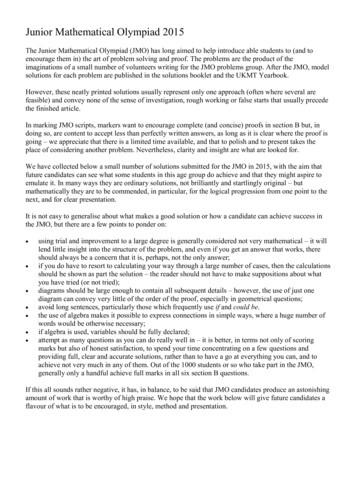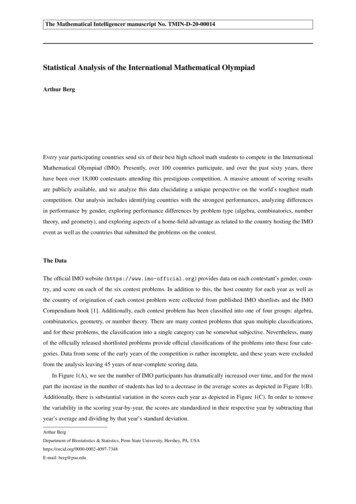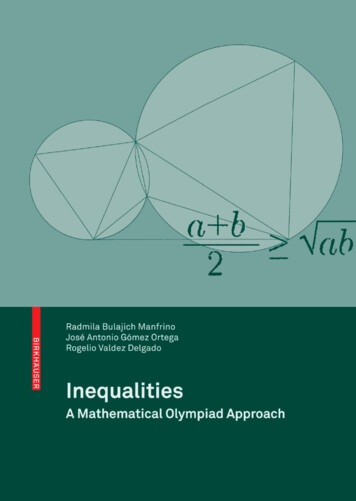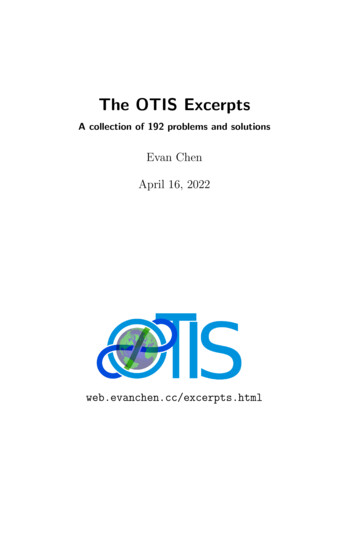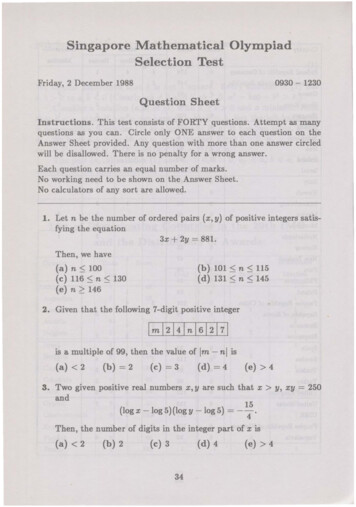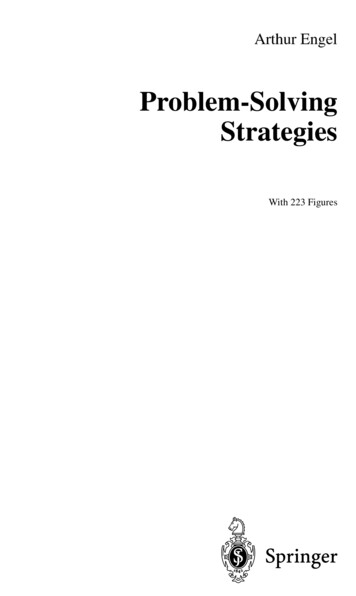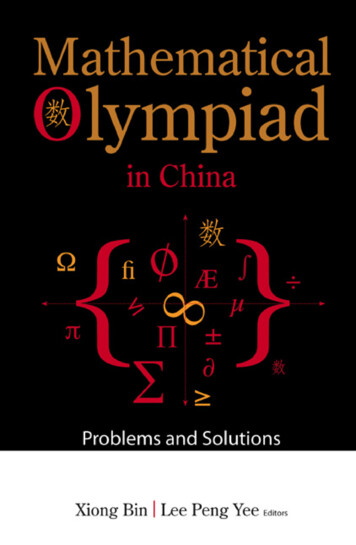
Transcription
MathematicalBlympiadin ChinaProblems and Solutions
This page intentionally left blank
MathematicalOlympiadin ChinaProblems and SolutionsEditorsXiong BinEast China Normal University, ChinaLee Peng YeeNanyang Technological University, SingaporeEast China NormalUniversity PressWorld Scientific
EditorsXIONG Bin East China o r m a lUniversity, ChinaLEE Peng Yee Nanpng Technological University, SingaporeOriginal AuthorsMO Chinese National Coaches Team of2003 - 2006English TranslatorsXIONG Bin East China N O T T UUniversity,Z ChinaFENG Zhigang shanghai High School, ChinaMA Guoxuan h s t China Normal University, ChinaLIN Lei East China ormalUniversity, ChinaWANG Shanping East China Normal university, ChinaZ m N G Zhongyi High School Affiliated to Fudan University, ChinaHA0 Lili Shanghai @baa Senior High School, ChinaWEE Khangping Nanpng Technological University, singuporeCopy EditorsNI Mingm t China NO UniversityZpress, ChinaZ M G Ji World Scientific Publishing GI., Singaporexu Jin h s t China Normal Universitypress, ChinaV
This page intentionally left blank
PrefaceThe first time China sent a team to IMO was in 1985. At that time, twostudents were sent to take part in the 26th IMO. Since 1986, China hasalways sent a team of 6 students to IMO except in 1998 when it was held in%wan. So far (up to 2006) , China has achieved the number one ranking inteam effort for 13 times. A great majority of students have received goldmedals. The fact that China achieved such encouraging result is due to, onone hand, Chinese students’ hard working and perseverance, and on the otherhand, the effort of teachers in schools and the training offered by nationalcoaches. As we believe, it is also a result of the educational system in China,in particular, the emphasis on training of basic skills in science education.The materials of this book come from a series of four books (inChinese) on Forurzrd to IMO: a collection of mathematical Olympiadproblems (2003 - 2006). It is a collection of problems and solutions of themajor mathematical competitions in China, which provides a glimpse onhow the China national team is selected and formed. First, it is the ChinaMathematical Competition, a national event, which is held on the secondSunday of October every year. Through the competition, about 120students are selected to join the China Mathematical Olympiad (commonlyknown as the Winter Camp) , or in short CMO, in January of the secondyear. CMO lasts for five days. Both the type and the difficulty of theproblems match those of IMO. Similarly, they solve three problems everyday in four and half hours. From CMO, about 20 to 30 students areselected to form a national training team. The training lasts for two weeksin March every year. After six to eight tests, plus two qualifyingvii
viiiMathematical Olympiad in Chinaexaminations, six students are finally selected to form the national team, totake part in IMO in July that year.Because of the differences in education, culture and economy ofWest China in comparison with East China, mathematicalcompetitions in the west did not develop as fast as in the east. Inorder to promote the activity of mathematical competition there,China Mathematical Olympiad Committee conducted the ChinaWestern Mathematical Olympiad from 2001. The top two winners willbe admitted to the national training team. Through the ChinaWestern Mathematical Olympiad, there have been two students whoentered the national team and received Gold Medals at IMO.Since 1986, the china team has never had a female student. Inorder to encourage more female students to participate in themathematical competition, starting from 2002, China MathematicalOlympiad Committee conducted the China Girls’ mathematicalOlympiad. Again, the top two winners will be admitted directly intothe national training team.The authors of this book are coaches of the China national team.They are Xiong Bin, Li Shenghong, Chen Yonggao , Leng Gangsong,Wang Jianwei, Li Weigu, Zhu Huawei, Feng Zhigang, WangHaiming, Xu Wenbin, Tao Pingshen, and Zheng Chongyi. Thosewho took part in the translation work are Xiong Bin, Feng Zhigang,Ma Guoxuan, Lin Lei, Wang Shanping, Zheng Chongyi, and HaoLili. We are grateful to Qiu Zhonghu, Wang Jie, Wu Jianping, andPan Chengbiao for their guidance and assistance to authors. We aregrateful to Ni Ming and Xu Jin of East China Normal UniversityPress. Their effort has helped make our job easier. We are alsograteful to Zhang Ji of World Scientific Publishing for her hard workleading to the final publication of the book.AuthorsMarch 2007
IntroductionEarly daysThe International Mathematical Olympiad (IMO) , founded in 1959,is one of the most competitive and highly intellectual activities in theworld for high school students.Even before IMO, there were already many countries which hadmathematics competition. They were mainly the countries in EasternEurope and in Asia. In addition to the popularization of mathematicsand the convergence in educational systems among differentcountries, the success of mathematical competitions at the nationallevel provided a foundation for the setting-up of IMO. The countriesthat asserted great influence are Hungary, the former Soviet Unionand the United States. Here is a brief review of the IMO andmathematical competition in China.In 1894, the Department of Education in Hungary passed amotion and decided to conduct a mathematical competition for thesecondary schools. The well-known scientist, 1. volt Etovos , was theMinister of Education at that time. His support in the event had madeit a success and thus it was well publicized. In addition, the success ofhis son, R . volt Etovos , who was also a physicist , in proving theprinciple of equivalence of the general theory of relativity by A .Einstein through experiment, had brought Hungary to the world stagein science. Thereafter, the prize for mathematics competition inHungary was named “Etovos prize”. This was the first formallyorganized mathematical competition in the world. In what follows,
XMathematical Olympiad in ChinaHungary had indeed produced a lot of well-known scientists includingL. Fejer, G. Szego, T . Rado, A . Haar and M . Riesz (in realanalysis), D. Konig ( in combinatorics) , T. von Kdrmdn ( inaerodynamics) , and 1. C. Harsanyi (in game theory, who had alsowon the Nobel Prize for Economics in 1994). They all were thewinners of Hungary mathematical competition. The top scientificgenius of Hungary, 1. von Neumann, was one of the leadingmathematicians in the 20th century. Neumann was overseas while thecompetition took place. Later he did it himself and it took him halfan hour to complete. Another mathematician worth mentioning is thehighly productive number theorist P. Erdos. He was a pupil of Fejerand also a winner of the Wolf Prize. Erdos was very passionate aboutmathematical competition and setting competition questions. Hiscontribution to discrete mathematics was unique and greatlysignificant. The rapid progress and development of discretemathematics over the subsequent decades had indirectly influenced thetypes of questions set in IMO. An internationally recognized prizenamed after Erdos was to honour those who had contributed to theeducation of mathematical competition. Professor Qiu Zonghu fromChina had won the prize in 1993.In 1934, B. Delone, a famous mathematician, conducted amathematical competition for high school students in Leningrad (nowSt. Petersburg). In 1935, Moscow also started organizing such event.Other than being interrupted during the World War II , these eventshad been carried on until today. As for the Russian MathematicalCompetition ( later renamed as the Soviet MathematicalCompetition) , it was not started until 1961. Thus, the former SovietUnion and Russia became the leading powers of MathematicalOlympiad. A lot of grandmasters in mathematics including A . N.Kolmogorov were all very enthusiastic about the mathematicalcompetition. They would personally involve in setting the questionsfor the competition. The former Soviet Union even called it theMathematical Olympiad, believing that mathematics is the
Introductionxi“gymnastics of thinking”. These points of view gave a great impact onthe educational community. The winner of the Fields Medal in 1998,M. Kontsevich, was once the first runner-up of the RussianMathematical Competition. G . Kasparov , the international chessgrandmaster, was once the second runner-up. Grigori Perelman , thewinner of the Fields Medal in 2006, who solved the Poincare’sConjecture, was a gold medalist of IMO in 1982.In the United States of America, due to the active promotion bythe renowned mathematician Birkhoff and his son, together with G .Polya , the Putnam mathematics competition was organized in 1938for junior undergraduates. Many of the questions were within thescope of high school students. The top five contestants of the Putnammathematical competition would be entitled to the membership ofPutnam. Many of these were eventually outstanding mathematicians.There were R . Feynman (winner of the Nobel Prize for Physics,1965), K . Wilson (winner of the Nobel Prize for Physics, 1982), 1.Milnor (winner of the Fields Medal, 1962), D. Mumford (winner ofthe Fields Medal, 1974), D. Quillen (winner of the Fields Medal,1978), et al.Since 1972, in order to prepare for the IMO, the United States ofAmerican Mathematical Olympiad ( USAMO) was organized. Thestandard of questions posed was very high, parallel to that of theWinter Camp in China. Prior to this, the United States had organizedAmerican High School Mathematics Examination (AHSME) for thehigh school students since 1950. This was at the junior level yet themost popular mathematics competition in America. Originally, it wasplanned to select about 100 contestants from AHSME to participate inUSAMO. However, due to the discrepancy in the level of difficultybetween the two competitions and other restrictions, from 1983onwards, an intermediate level of competition, namely, AmericanInvitational Mathematics Examination ( AIME ) , was introduced.Henceforth both AHSME and AIME became internationally wellknown. A few cities in China had participated in the competition and
xiiMathematical Olympiad in Chinathe results were encouraging.The members of the national team who were selected fromUSAMO would undergo training at the West Point Military Academy,and would meet the President at the White House together with theirparents. Similarly as in the former Soviet Union, the MathematicalOlympiad education was widely recognized in America. The book“HOWto Solve it” written by George Polya along with many othertitles had been translated into many different languages. George Polyaprovided a whole series of general heuristics for solving problems ofall kinds. His influence in the educational community in China shouldnot be underestimated.International Mathematical OlympiadIn 1956, the East European countries and the Soviet Union took theinitiative to organize the IMO formally. The first InternationalMathematical Olympiad (IMO) was held in Brasov, Romania, in1959. At the time, there were only seven participating countries,namely , Romania , Bulgaria, Poland , Hungary , Czechoslovakia, EastGermany and the Soviet Union. Subsequently, the United States ofAmerica, United Kingdom, France, Germany and also othercountries including those from Asia joined. Today, the IMO hadmanaged to reach almost all the developed and developing countries.Except in the year 1980 due to financial difficulties faced by the hostcountry, Mongolia, there were already 47 Olympiads held and 90countries participating.The mathematical topics in the IMO include number theory,polynomials, functional equations, inequalities, graph theory,complex numbers, combinatorics, geometry and game theory. Theseareas had provided guidance for setting questions for thecompetitions. Other than the first few Olympiads, each IMO isnormally held in mid-July every year and the test paper consists of 6questions in all. The actual competition lasts for 2 days for a total of 9hours where participants are required to complete 3 questions each
Introductionxiday. Each question is 7 marks which total up to 42 marks. The fullscore for a team is 252 marks. About half of the participants will beawarded a medal, where 1/12 will be awarded a gold medal. Thenumbers of gold, silver and bronze medals awarded are in the ratio of1:2:3 approximately. In the case when a participant provides a bettersolution than the official answer, a special award is given.Each participating country will take turn to host the IMO. Thecost is borne by the host country. China had successfully hosted the31st IMO in Beijing in 1990. The event had made a great impact onthe mathematical community in China. According to the rules andregulations of the IMO, all participating countries are required tosend a delegation consisting of a leader, a deputy leader and 6contestants. The problems are contributed by the participatingcountries and are later selected carefully by the host country forsubmission to the international jury set up by the host country.Eventually, only 6 problems will be accepted for use in thecompetition. The host country does not provide any question. Theshort-listed problems are subsequently translated, if necessary , inEnglish, French, German, Russian and other working languages.After that , the team leaders will translate the problems into their ownlanguages.The answer scripts of each participating team will be marked bythe team leader and the deputy leader. The team leader will laterpresent the scripts of their contestants to the coordinators forassessment. If there is any dispute, the matter will be settled by thejury. The jury is formed by the various team leaders and an appointedchairman by the host country. The jury is responsible for deciding thefinal 6 problems for the competition. Their duties also includefinalizing the marking standard, ensuring the accuracy of thetranslation of the problems, standardizing replies to written queriesraised by participants during the competition, synchronizingdifferences in marking between the leaders and the coordinators andalso deciding on the cut-off points for the medals depending on the
xivMathematical Olympiad in Chinacontestants’ results as the difficulties of problems each year aredifferent.China had participated informally in the 26th IMO in 1985. Onlytwo students were sent. Starting from 1986, except in 1998 when theIMO was held in Taiwan, China had always sent 6 official contestantsto the IMO. Today, the Chinese contestants not only performedoutstandingly in the IMO, but also in the International Physics,Chemistry, Informatics, and Biology Olympiads. So far, no othercountries have overtaken China in the number of gold and silvermedals received. This can be regarded as an indication that Chinapays great attention to the training of basic skills in mathematics andscience education.Winners of the IMOAmong all the IMO medalists, there were many of them whoeventually became great mathematicians. Some of them were alsoawarded the Fields Medal, Wolf Prize or Nevanlinna Prize ( aprominent mathematics prize for computing and informatics). Inwhat follows, we name some of the winners.G . Margulis , a silver medalist of IMO in 1959, was awarded theFields Medal in 1978. L. Lovasz, who won the Wolf Prize in 1999,was awarded the Special Award in IMO consecutively in 1965 and1966. V. Drinfeld , a gold medalist of IMO in 1969, was awarded theFields Medal in 1990. 1. -C. Yoccoz and T . Gowers, who were bothawarded the Fields Medal in 1998, were gold medalists in IMO in 1974and 1981 respectively. A silver medalist of IMO in 1985, L.Lafforgue , won the Fields Medal in 2002. A gold medalist of IMO in1982, Grigori Perelman from Russia, was awarded the Fields Medal in2006 for solving the final step of the Poincar6 conjecture. In 1986,1987, and 1988, Terence Tao won a bronze, silver, and gold medalrespectively. He was the youngest participant to date in the IMO,first competing at the age of ten. He was also awarded the FieldsMedal in 2006.
IntroductionxvA silver medalist of IMO in 1977, P. Shor, was awarded theNevanlinna Prize. A gold medalist of IMO in 1979, A . Razborov ,was awarded the Nevanlinna Prize. Another gold medalist of IMO in1986, S. Smirnov, was awarded the Clay Research Award. V.Lafforgue, a gold medalist of IMO in 1990, was awarded theEuropean Mathematical Society prize. He is L. Laforgue’s youngerbrother.Also, a famous mathematician in number theory, N. Elkis, whois also a foundation professor at Havard University, was awarded agold medal of IMO in 1981. Other winners include P. Kronheimerawarded a silver medal in 1981 and R . Taylor a contestant of IMO in1980.MathematicaI competitions in ChinaDue to various reasons , mathematical competitions in China startedrelatively late but is progressing vigorously.“We are going to have our own mathematical competition too!”said Hua Luogeng. Hua is a house-hold name in China. The firstmathematical competition was held concurrently in Beijing , Tianjing,Shanghai and Wuhan in 1956. Due to the political situation at thetime, this event was interrupted a few times. Until 1962, when thepolitical environment started to improve, Beijing and other citiesstarted organizing the competition though not regularly. In the era ofcultural revolution, the whole educational system in China was inchaos. The mathematical competition came to a complete halt. Incontrast, the mathematical competition in the former Soviet Unionwas still on-going during the war and at a time under the difficultpolitical situation. The competitions in Moscow were interrupted only3 times between 1942 and 1944. It was indeed commendable.In 1978, it was the spring of science. Hua Luogeng conducted theMiddle School Mathematical Competition for 8 provinces in China.The mathematical competition in China was then making a fresh startand embarked on a road of rapid development. Hua passed away in
xviMathematical Olympiad in China1985. In commemorating him, a competition named Hua LuogengGold Cup was set up in 1986 for the junior middle school students andit had a great impact.The mathematical competitions in China before 1980 can beconsidered as the initial period. The problems set were within thescope of middle school textbooks. After 1980, the competitions weregradually moving towards the senior middle school level. In 1981, theChinese Mathematical Society decided to conduct the ChinaMathematical Competition, a national event for high schools.In 1981, the United States of America, the host country of IMO,issued an invitation to China to participate in the event. Only in 1985,China sent two contestants to participate informally in the IMO. Theresults were not encouraging. In view of this, another activity calledthe Winter Camp was conducted after the China MathematicalCompetition. The Winter Camp was later renamed as the ChinaMathematical Olympiad or CMO. The winning team would beawarded the Chern Shiing-Shen Cup. Based on the outcome at theWinter Camp, a selection would be made to form the 6-membernational team for IMO. From 1986 onwards, other than the yearwhen IMO was organized in Taiwan, China had been sending a 6member team to IMO every year. China is normally awarded thechampion or first runner-up except on three occasions when the resultswere lacking. Up to 2006, China had been awarded the overall teamchampion for 13 times.In 1990, China had successfully hosted the 31st IMO. It showedthat the standard of mathematical competition in China has leveledthat of other leading countries. First, the fact that China achieves thehighest marks at the 31st IMO for the team is an evidence of theeffectiveness of the pyramid approach in selecting the contestants inChina. Secondly, the Chinese mathematicians had simplified andmodified over 100 problems and submitted them to the team leaders ofthe 35 countries for their perusal. Eventually, 28 problems wererecommended. At the end, 5 problems were chosen O M 0 requires 6
Introductionxviiproblems). This is another evidence to show that China has achievedthe highest quality in setting problems. Thirdly, the answer scripts ofthe participants were marked by the various team leaders and assessedby the coordinators who were nominated by the host countries. Chinahad formed a group 50 mathematicians to serve as coordinators whowould ensure the high accuracy and fairness in marking. The markingprocess was completed half a day earlier than it was scheduled.Fourthly, that was the first ever IMO organized in Asia. Theoutstanding performance by China had encouraged the otherdeveloping countries, especially those in Asia. The organizing andcoordinating work of the IMO by the host country was also reasonablygood.In China, the outstanding performance in mathematicalcompetition is a result of many contributions from all the quarters ofmathematical community. There are the older generation ofmathematicians, middle-aged mathematicians and also the middle andelementary school teachers. There is one person who deserves aspecial mention and he is Hua Luogeng. He initiated and promotedthe mathematical competition. He is also the author of the followingbooks: Beyond Yang hui’s Triangle, Beyond the pi of Zu Chongzhi ,Beyond the Magic Computation of Sun-zi , Mathematical Induction,and Mathematical Problems of Bee Hive. These books were derivedfrom mathematics competitions. When China resumed mathematicalcompetition in 1978, he participated in setting problems and givingcritique to solutions of the problems. Other outstanding books derivedfrom the Chinese mathematics competitions are: Symmetry by DuanXuefu, Lattice and Area by He Sihe, One Stroke Drawing andPostman Problem by Jiang Boju .After 1980, the younger mathematicians in China had taken overfrom the older generation of mathematicians in running themathematical competition. They worked and strived hard to bring thelevel of mathematical competition in China to a new height. QiuZonghu is one such outstanding representative. From the training of
xviiiMathematical Olympiad in Chinacontestants and leading the team 3 times to IMO to the organizing ofthe 31th IMO in China, he had contributed prominently and wasawarded the P. Erdos prize.Preparation for IMOCurrently, the selection process of participants for IMO in China is asfollows.First, the China Mathematical Competition, a nationalcompetition for high Schools, is organized on the second Sunday inOctober every year. The objectives are: to increase the interest ofstudents in learning mathematics, to promote the development of cocurricular activities in mathematics, to help improve the teaching ofmathematics in high schools, to discover and cultivate the talents andalso to prepare for the IMO. This happens since 1981. Currently thereare about 200 000 participants taking part.Through the China Mathematical Competition, around 120 ofstudents are selected to take part in the China Mathematical Olympiador CMO, that is, the Winter Camp. The CMO lasts for 5 days and isheld in January every year. The types and difficulties of the problemsin CMO are very much similar to the IMO. There are also 3 problemsto be completed within four and half hours each day. However, thescore for each problem is 21 marks which add up to 126 marks intotal. Starting from 1990, the Winter Camp instituted the ChernShiing-Shen Cup for team championship. In 1991, the Winter Campwas officially renamed as the China Mathematical Olympiad (CMO) .It is similar to the highest national mathematical competition in theformer Soviet Union and the United States.The CMO awards the first, second and third prizes. Among theparticipants of CMO, about 20 to 30 students are selected toparticipate in the training for IMO. The training takes place in Marchevery year. After 6 to 8 tests and another 2 rounds of qualifyingexaminations, only 6 contestants are short-listed to form the ChinaIMO national team to take part in the IMO in July.
IntroductionXiXBesides the China Mathematical Competition (for high schools) ,the Junior Middle School Mathematical Competition is also developingwell. Starting from 1984, the competition is organized in April everyyear by the Popularization Committee of the Chinese MathematicalSociety. The various provinces, cities and autonomous regions wouldrotate to host the event. Another mathematical competition for thejunior middle schools is also conducted in April every year by theMiddle School Mathematics Education Society of the ChineseEducational Society since 1998 till now.The Hua Luogeng Gold Cup, a competition by invitation, hadalso been successfully conducted since 1986. The participating studentscomprise elementary six and junior middle one students. The formatof the competition consists of a preliminary round, semifinals invarious provinces, cities and autonomous regions, then the finals.Mathematical competition in China provides a platform forstudents to showcase their talents in mathematics. It encourageslearning of mathematics among students. It helps identify talentedstudents and to provide them with differentiated learningopportunity. It develops co-curricular activities in mathematics.Finally, it brings about changes in the teaching of mathematics.
This page intentionally left blank
ContentsPrefacelntroductionviiixChina Mathematical )(Hainan)(Jiangxi)China Mathematical Competition (Extra gxi)China Mathematical Olympiad2003200420052006(Changsha, Hunan)(Macao)(Zhengzhou, Henan)(Fuzhou, Fujian)China Girls’ Mathematical Olympiad2002200320042005(Zhuhai, Guangdong)(Wuhan, Hubei)(Nanchang , Jiangxi)(Changchun, Jilin)515155606774749099113126126134142156
Mathematical Olympiad in ChinaxxiiChina Western Mathematical Olympiad1662002200320042005(Lanzhou, Gansu)(Urumqi, Xinjiang)(Yinchuan, Ningxia)(Chengdu, Sichuan)International Mathematical 3(Tokyo, Japan)(Athens, Greece)(Mkrida, Mexico)(Ljubljana, Slovenia)
China MathematicalCompetitionT h e China Mathematical Competition is organiEd in Octoberevery year. The Popularization Committee of the ChineseMathematical Society and the local Mathematical Society areresponsible for the assignments of the competition problems.The test paper consists of 6 choices, 6 blanks and 3questions to be solved with complete process. The full score is150 marks. Besides, 3 questions are used in the Extra Test, with50 marks each. The participants with high total marks in the ChinaMathematical Competition plus the Extra Test are awarded the firstprize (1 000 participants around China), and they will be admittedinto the university directly.The participants with excellent marks are selected to take partin the China Mathematical Olympiad the next year. Thus, forChinese high school students, the China Mathematical Olympiadis the first step to IMO.
Mathematical Olympiad in China22002(Jilin)Popularization Committee of CMS and Jilin Mathematical Societywere responsible for the assignment of the competition problems inthe first and second rounds of the contests.Part I Multiple-choice Questions (Questions1 to 6 carry 6 marks each.)@@ The interval on which the function f ( x ) log (2- 2x - 3 ) ismonotone increasing is ().(A) (Em, -1)( 3) (Em, 1)(C)( l , m )(D) (3, m Solution First, we will find the domain of f(x). From 2 - 2x 3 0, we obtain x - 1 or x 3. So the domain of definition forf(x)is(--,-1)U (3, m). B u t u 2 - 2 x - 3 ( -1) 4 is monotone decreasing on (- 00 , - 1) , and monotone increasing on(3 , 00). So fcx) log3 (2- 2x - 3) is monotone increasing on(- 00 , - 1) , and monotone decreasing on (3 , 00). Answer: A. If r e a l n u m b e r s x a n d y s a t i s f y ( 5 ) ( y - 1 2 ) 1 4 then,the minimum value of 2 3 is (). (A) 2(B) 1(C)43(D) ./zSolution Let x 5 14cosOand y - 12 14sin0, for 0 E [0, 2x).Hence 142 52 122- 365 28(12sin8-1 4 0 08 s 336sin 05 0 8)
China Mathematical Competition 20023 28 x 13sidO- 9) 365 364sidO- 9) , 3655where t a n 9 12'So 2x513 has the minimum value 1, when O - andy --.12133x25i. e.12- arctan-,Answer: B. Remark A geometric significance of this problem is: ( x 5 I 2( y - 1212 142is a circle with C(- 5, 12) as center and 14 as radius.We can find a point P on the circumference of this circle such thatI PO I is minimal, where 0 is the origin of the coordinate system.We join CO and extend it to intersect the circumference of the circleat P. Then it follows that I PO I is the minimum value of 2 y2.XXis ( .1-2x2(A) an even but not odd function(B) an odd but not even function(C)a both even and odd function(D) a neither even nor odd functionSolution It is easy to see that the domain of f (x) is ((0, -I.Whenx E (--, 0) U (0, -I, we have@& The function f (x) ---X1-2xX2--,0)Ufh .Therefore, f ( x ) is an even function, and obviously not an odd
Mathematical Olympiad in China4function. Answer: A.c% The straight line 4 3.-I 2 2 1 at1 intersects the ellipse 169two points A and B. There is a point P on this ellipse such that) such point/the area of APAB is equal to 3. There is/are (points P.(A) 1(B) 2(C)3(D) 4Solution Suppose that there is a point P(4cosa, 3sina) on theellipse. When P and the origin 0 are not on the same side of AB , thedistance from P to AB is3 ( 4 0a) s 4(3sina)- 125125 -(cosa sina-1) 76 .But AB 5,1 X5X 6 3.SOAPAB -52Therefore, when the area of APAB is equal to 3 , points P and 0are on the same side of AB . There are two such points P. Answer: B.&@It is given that there are two sets of real numbers A { a l , a2,q o o ) and B { b l , b 2 , .-, b50). If there is amapping f from A to B such that every element in B has aninverse image and.a,f(a1) f ( a 2 I . f(a1oo
X Mathematical Olympiad in China Hungary had indeed produced a lot of well-known scientists including L. Fejer, G. Szego, T. Rado, A. Haar and M. Riesz (in real analysis), D. Konig ( in combinatorics) , T. von Kdrmdn ( in aerodynamics) , and 1.C. Harsanyi (in game theory, who had also won the Nobel Prize for Economics in 1994).
